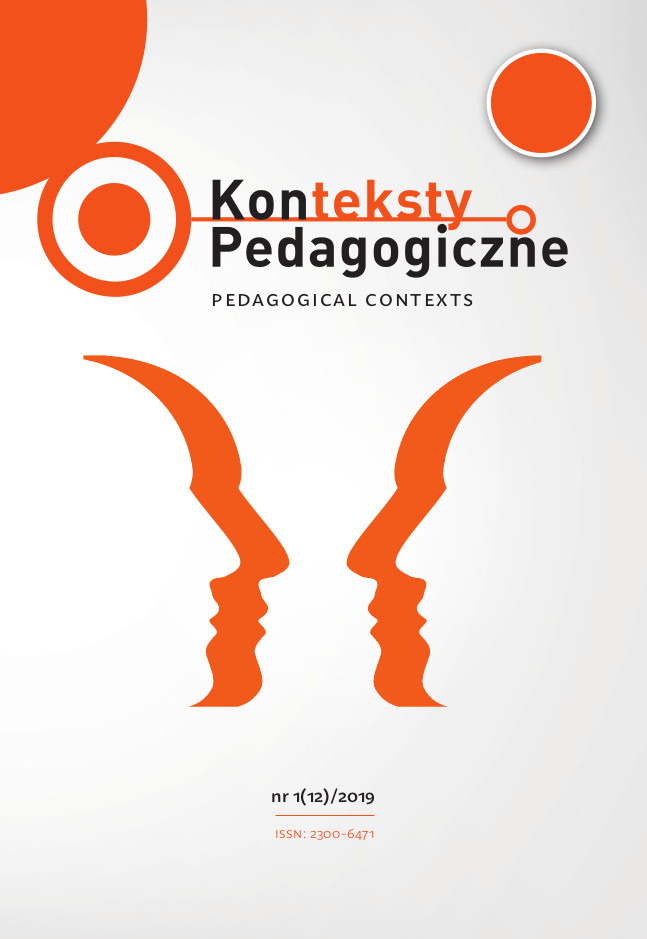Abstract
The aim of the article is to present the design and carry out a preliminary assessment of the psychometric properties of the Situational Motivation Scale SMS-15 for children based on Deci and Ryan’s Self-determination Theory. Three hundred children aged 11-15 (178 girls and 122 boys) took part in the validation study. The SMS-15 scale has satisfactory theoretical accuracy, internal consistency and reliability. Cronbach’s α coefficient equals .84 for the subscales of introjected motivation and regulation by identification; whereas for the subscales of intrinsic motivation, external regulation and amotivation it equals .82.
References
Bedyńska, S. and Książek, M. (2012). Statystyczny drogowskaz: praktyczny przewodnik wykorzystania modeli regresji oraz równań strukturalnych [Statistical Signpost: A Practical Guide to the Use of Regression Models and Structural Equations]. Warszawa: Wydawnictwo Akademickie Sedno.
Brophy, J. (2002). Motywowanie uczniów do nauki [Motivating Students to Learn], transl. K. Kruszewski. Warszawa: Wydawnictwo Naukowe PWN.
Byrne, B. (2010). Structural equation modeling with AMOS: basic concepts, applications, and programming (multivariate applications series). New York: Taylor and Francis Group.
Deci, E. and Ryan, R. (1975). Intrinsic motivation. New York: Plenum Press.
Deci, E. and Ryan, R. (2000). The “What” and “Why” of Goal Pursuits: Human Needs and the Self-Determination of Behavior. Psychological Inquiry, 11(4), 227–268.
Deci, E. and Ryan, R. (2008). Self-Determination Theory: A Macrotheory of Human Motivation, Development, and Health. Canadian Psychology, 49, 182–185.
Deci, E. and Vansteenkiste, M. (2004). Self-determination theory and basic need satisfaction: Understanding human development in positive psychology. Ricerche di Psicologia, 27, 23–40.
Góźdź, J. (2015). Konstrukcja kwestionariusza motywacji do nauki w oparciu o koncepcję Self-Determination Theory E. Deciego, R.M. Ryana [The Construction of a Questionnaire on Motivation in Education on the Basis of the Self-Determination Theory of E. Deci and R.M. Ryan]. Przegląd Pedagogiczny, 1(29), 263–270.
Huta, V. and Ryan, R. (2010). Pursuing pleasure or virtue: The differential and overlapping well-being benefits of hedonic and eudaimonic motives. Journal of Happiness Studies, 11(6), 735–762.
Janeiro, I. (2010). Motivational dynamics in the development of career attitudes among adolescents. Journal of Vocational Behavior, 76(2), 170–177.
Jankowski, K. and Zajenkowski, M. (2009). Jakich informacji o teście dostarcza testowanie? [What Information Does Testing Provide About the Test?] In: K. Fronczyk (ed.), Psychometria. Podstawowe zagadnienia (s. 84–110). Warszawa: Wyższa Szkoła Finansów i Zarządzania w Warszawie.
Kozielecki, J. (1998). Koncepcje psychologiczne człowieka [Psychological Concepts of a Human Being]. Warszawa: Wydawnictwo Akademickie Żak.
Lawshe, C. (1975). A quantitative approach to content validity. Personnel Psychology, 28, 563–575.
Lekes, N., Gingras, I., Philippe, F., Koestner, R. and Fang., J. (2010). Parental Autonomy Support, Intrinsic Life Goals, and Well-Being Among Adolescents in China and North America. Journal of Youth and Adolescence, 39(8), 858–869.
Lichtenberg, J., Lachmann, F., Fosshage, J. (2016). Self and motivational systems: Towards a theory of psychoanalytic technique. New York: Routledge.
Mageau, G., Vallerand, R., Charest, J., Salvy, S., Lacaille, N., Bouffard, T. and Koestner, R. (2009). On the development of harmonious and obsessive passion: The role of autonomy support, activity specialization, and identification with the activity. Journal of Personality, 77, 601–646.
Meyer, J. and Gagne, M. (2008). Employee engagement from a self-determination theory perspective. Industrial and Organizational Psychology, 1, 60–62.
Ryan, R., Huta, V. and Deci, E. (2008). Living well: A self-determination theory perspective on eudaimonia. Journal of Happiness Studies, 9(1), 139–170.
Schreiber, J., Nora, A., Stage, F., Barlow, E. and King, J. (2006). Reporting structural equation modeling and confirmatory factor analysis results: A review. The Journal of Educational Research, 99(6), 323–338.
Sterczyński, R., Burczyk, P., Tucholska, K., Konwińska, M., Gmińska, B., Bławat, K., Kutajczyk, T. and Przychodzeń, B. (2010). Kwestionariusz Motywacji Szkolnej Gimnazjalisty [The School Motivation Questionnaire for Junior High School Students]. In: B. Niemierko and M. Szmigel (eds.), Teraźniejszość i przyszłość oceniania szkolnego: XVI Konferencja Diagnostyki Edukacyjnej [Present and future of school grading: 16th Conference of Educational Diagnostics] (pp. 140–152). Toruń: Grupa Tomami.
Vallerand, R. and Ratelle, C. (2002). Intrinsic and extrinsic motivation: A hierarchical model. Handbook of Self-determination Research, 128, 37–63.
Zwierzyńska, E. and Matuszewski, A. (2002). Kwestionariusz Ja i moja szkoła [The “Me and My School” Questionnaire]. Warszawa: CMPPP.
In accordance with the recommendation of the Ministry of Science and Higher Education, which aims to counteract the practice of “ghostwriting” and “guest authorship,” all authors submitting their text for publication should attach an author’s statement which declares the contribution of each of the authors to the article. The printed and signed statement should be delivered by mail or other means to editor-in-chief Joanna Skibska or sent in the form of a scan to the following e-mail address: redakcja@kontekstypedagogczne.pl. The authors will not receive remuneration for publishing their papers. The editors reserve the right to make minor editorial changes to the articles which will not affect the substance of the article. We encourage all authors to prepare their articles in accordance with the guidelines for manuscript preparation. Download pdf file.
Authors transfer all copyrights and grant the journal the right of first publication with the work simultaneously licensed under a Creative Commons Attribution License that allows others to share the work with acknowledgement of the work's authorship and initial publication in this journal. All authors agree to the publishing of their email addresses, affiliations and short bio statements with their articles during the submission process.

